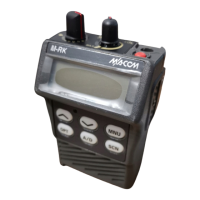• Controlling the DSP, flash E
2
PROM and RAM
• Loading data to the frequency synthesizer
• Fetching and processing the PTT, monitor, channel
selection, and volume control
• Controlling the LED display (M-RK I)
• Loading data to the LCD display processor (M-RK II
& Scan)
• Controlling the audio circuit (processor)
• Decoding the squelch
• Encoding/Decoding the Channel Guard and Digital
Channel Guard
• Controlling the loading interface for the radio data
(channel number and signaling)
Flash E
2
PROM (U4)
IC U4 contains the software to control the microproces-
sor.
Earlier versions of M-RK radios had 128K or 256K flash
memory. Refer to the white label on the bottom baseplate
assembly to determine the memory size. It will indicate
"937Pxxx". If "xxx" is >200, the M-RK has switchable hard-
ware and 512K flash memory. If "xxx" is <200, the M-RK
has non-switchable hardware and is either 128K or 256K
flash memory. Contact Technical Assistance Center for addi-
tional information.
RAM (U5)
This RAM has a storage capacity of 32 Kbits x 8. Earlier
versions had 8K RAM.
E
2
PROM (U6)
This E
2
PROM has a storage capacity of 2 Kbit x 8. This
personality controls various functions of the radio. The per-
sonality data is entered from outside the radio through the
UDC connector to the microprocessor and then to the
E
2
PROM. The data mainly consists of the following:
• Channel frequency Data
• CG/DCG data
• TX Power, TX Modulation Data
• Squelch Data
• Display Data, etc.
Digital Signal Processor (DSP)(U3)
The primary purpose of this DSP is to off-load the host
microprocessor so that the host can spend as much time as
possible in a low power state. This chip has the functions as
follows:
• MODEM
• FIFO
• Watch Dog Timer
• Clock Control
• Control Register Bank
• Interrupt Control
• Address Decode
Voltage Regulator (U9, U10)
Voltage regulator U9, U10, Q1 generate 5 VDC for Con-
trol Board and LCD/KB Flex Board.
Audio Amplifier (U11)
The audio amplifier is located between the audio proces-
sor and the speaker. Amplifier U11 amplifies the output sig-
nal of the ASP (U7) to the level adequate for driving the
speaker and UDC audio output.
Audio Signal Processor (ASP)(U7)
The Audio processor consists of a one-chip IC accommo-
dating almost all the audio functions. The audio functions
are under control of the microcomputer in compliance with
the function of the radio unit. The functions of the audio
processor are as follows:
• Rx Audio process with Tone Reject Filter,
De-Emphasis and Programmable Attenuater.
• Data limiting
• CG/DCG filtering and limiting
• Noise Squelch filtering and detecting
• 8 bits D/A Converter with sample and hold
• Tx audio process with Mic Amplifier, Pre-Emphasis,
Deviation Limiter, Summing Amplifier, Post Limiter
filter and Programmable Attenuater.
• Data signal filtering
• Two 6 bits Programmable Divider for clock and alert
tone.
All these functions are made up of switched capacitor fil-
ters, amplifiers, and timing logic. The timing for this logic is
derived from the 4.9152 MHz clock generator (DSP).
LBI-38735
11

